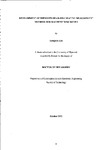DEVELOPMENT OF IMPROVED HEAD-DISK SPACING MEASUREMENT METHODS FOR MAGNETIC DISK DRIVES
| dc.contributor.author | LIU, XINQUN | |
| dc.contributor.other | Faculty of Science and Engineering | en_US |
| dc.date.accessioned | 2013-11-22T16:05:11Z | |
| dc.date.available | 2013-11-22T16:05:11Z | |
| dc.date.issued | 2002 | |
| dc.identifier | NOT AVAILABLE | en_US |
| dc.identifier.uri | http://hdl.handle.net/10026.1/2830 | |
| dc.description.abstract |
A detailed review of existing flying height or head disk spacing testing techniques has been made, and in-depth analyses of the working principles of the currently popular optical interferometry flying height testing methods are presented with simulation results. A new dual-beam normal incidence polarisation inteferometry method is then proposed. One advantage of this dual-beam polarisation interferometry is that it can be used for both the direct spacing measurement (DSM) method and relative displacement measuring (RDM) method. The RDM method is a good way to measure the head-disk spacing and the slider pitch or roll when a real magnetic disk is used for testing. The DSM method has the advantage that the absolute head-disk spacing can be observed and measured directly, especially in the case where it is difficult for the light beam to 'spot' the back surface of the head-slider. When used for the DSM method, the flying height can be measured down to contact without losing sensitivity. Slider pitch or roll can also be measured using the phase information. Another advantage of this polarisation interferometry is that, when used for the DSM method, with the measured intensity and phase information, the optical constants of the slider material can be determined, which is necessary to determine the flying height. By investigation of the application limits and potential problems of the intensity interferometry method, an improved intensity interferometry method is also proposed by using phase-shifting technique to improve the sensitivity of this method when the head-disk spacing is below 10 nm and near contact. An experimental testing system has been built to test the capability and effectiveness of the proposed interferometry methods. Experimental results are presented which show good agreement with the results gained from theoretical analyses and simulation. | en_US |
| dc.language.iso | en | en_US |
| dc.publisher | University of Plymouth | en_US |
| dc.title | DEVELOPMENT OF IMPROVED HEAD-DISK SPACING MEASUREMENT METHODS FOR MAGNETIC DISK DRIVES | en_US |
| dc.type | Thesis | |
| plymouth.version | Full version | en_US |
| dc.identifier.doi | http://dx.doi.org/10.24382/4924 |
Files in this item
This item appears in the following Collection(s)
-
01 Research Theses Main Collection
Research Theses Main


